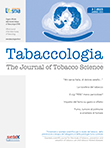|
Rassegna Stampa Scientifica Luglio 2021
Letters Government ambition to make England smoke-free by 2030 Open letter to the prime minister and secretary of state on the second anniversary of England’s announcement that it would be smoke-free by 2030 BMJ 2021;374:n1839 (Published 21 July 2021) Nicholas S Hopkinson, Helen Stokes-Lampard, Jennifer Dixon, Maggie Rae, Linda Bauld, Bruce and John Usher Sarah Woolnough, Andrew Goddard, Jeanelle de Gruchy, Charmaine Griffiths, Ian Walker, Jon Bennett https://www.bmj.com/content/374/bmj.n1839 https://www.bmj.com/content/bmj/374/bmj.n1839.full.pdf Note: Open Access.
Related PR:
Government has failed to deliver on smoke free pledge for England https://medicalxpress.com/news/2021-07-free-pledge-england.html
"Despite the added risk of foetal harm during pregnancy, there is no evidence that the tobacco consumption between pregnant and non-pregnant women differ in 42 LMICs [low- and middle-income countries]. A significantly higher use of smokeless tobacco among pregnant women in SEAR [South-East Asia Region] is of particular concern and warrants further investigation."
Tobacco Use Among 1 310 716 Women of Reproductive age (15–49 Years) in 42 Low- and Middle-Income Countries: Secondary Data Analysis From the 2010-2016 Demographic and Health Surveys Nicotine & Tobacco Research, ntab131. Published: 22 July 2021 Radha Shukla, Mona Kanaan, Kamran Siddiqi https://academic.oup.com/ntr/advance-article/doi/10.1093/ntr/ntab131/6325040 Note: Open Access.
Also:
Smoking Cessation and Preterm Birth in Second Pregnancy Among Women who Smoked in Their First https://academic.oup.com/ntr/advance-article-abstract/doi/10.1093/ntr/ntab135/6326813 Trends in the Number and Type of Tobacco Product Retailers, United States, 2000-2017 https://academic.oup.com/ntr/advance-article-abstract/doi/10.1093/ntr/ntab150/6327606 Vaping disparities at the intersection of gender identity and race/ethnicity in a population-based sample of adolescents https://academic.oup.com/ntr/advance-article-abstract/doi/10.1093/ntr/ntab152/6326672
"Parent and child data from 10,625 [UK] youth assessed in infancy and modal ages 11, 14, and 17 years… Among youth who had not smoked tobacco by age 14 (n=9,046), logistic regressions estimated that teenagers who used e-cigarettes by age 14, compared with non e-cigarette users, had over 5 times higher odds of initiating tobacco smoking by age 17 (odds ratio (OR)=5.25, 95% confidence interval (CI):[3.28-8.38]), and nearly triple the odds of being a frequent tobacco smoker at age 17 (OR=2.91, 95% CI:[1.56-5.41]), net of risk factors and demographics... Conclusions: E-cigarette use by age 14 is associated with increased odds of tobacco cigarette initiation and frequent smoking at age 17 among British youth. Similarly, tobacco smoking at age 14 is associated with increased odds of both e-cigarette initiation and frequent use at age 17."
Adolescent Electronic Cigarette Use and Tobacco Smoking in the Millennium Cohort Study Addiction. 2021 Jul 19. Online ahead of print. Jeremy Staff, Brian C Kelly, Jennifer L Maggs, Mike Vuolo https://onlinelibrary.wiley.com/doi/10.1111/add.15645
"On average, participants preferred non-tobacco and non-menthol flavours most, preferred open-system over closed-system e-cigarettes and preferred regular nicotine level over low nicotine level. However, the preference varied by demographics, smoking status and the primarily used e-cigarette device and flavour… Conclusions: People are unlikely to switch to another product/device because of the restriction of flavour or nicotine level. If non-tobacco and non-menthol flavours were banned from open-system e-cigarettes, users may switch to menthol flavour e-cigarettes."
Impact of flavours, device, nicotine levels and price on adult e-cigarette users' tobacco and nicotine product choices Tob Control. 2021 Jul 22;tobaccocontrol-2021-056599. Online ahead of print. Yong Yang, Eric N Lindblom, Ramzi G Salloum, Kenneth D Ward https://tobaccocontrol.bmj.com/content/early/2021/07/22/tobaccocontrol-2021-056599
Also:
Price promotion receipt and use progression of any tobacco, cigarettes, e-cigarettes and cigars among US youth between 2016 and 2018 https://tobaccocontrol.bmj.com/content/early/2021/07/22/tobaccocontrol-2021-056667 Tobacco retail availability and cigarette and e-cigarette use among youth and adults: a scoping review https://tobaccocontrol.bmj.com/content/early/2021/07/22/tobaccocontrol-2020-056376 Online marketing activity following New Zealand's vaping legislation https://tobaccocontrol.bmj.com/content/early/2021/07/22/tobaccocontrol-2021-056750 Note: Retail availability paper Open Access.
"The complexity of e-liquid formulations and rapid evolution of different e-cigarette devices, coupled with regulations focused on narrowly defined e-cigarette products, have resulted in exploitation of regulatory loopholes and few substantive changes in overall e-cigarette product availability, appeal and use. Future regulations governing e-cigarette devices, flavours and chemical components will need to be rigorous and thorough, with careful consideration of ways in which companies may attempt to evade regulations by making small changes to their products."
Commentary Evolving chemical landscape of e-cigarettes, 2021 Tobacco Control Published Online First: 21 July 2021. Elise Hickman, Ilona Jaspers https://tobaccocontrol.bmj.com/content/early/2021/07/20/tobaccocontrol-2021-056808
Referenced Tob Control study:
Flavour chemicals, synthetic coolants and pulegone in popular mint-flavoured and menthol-flavoured e-cigarettes https://tobaccocontrol.bmj.com/content/early/2021/06/30/tobaccocontrol-2021-056582
"Logistic regressions found that e-cigarette use was associated with having had a myocardial infarction, but this association significantly varied on the basis of one's smoking history. With a host of demographic and clinical variables controlled, e-cigarette use was associated with lifetime myocardial infarction occurrence only among current smokers… Conclusions: There is no reliable evidence that e-cigarette use is associated with ever having had a myocardial infarction among never smokers. Contrary to concerns that the harms associated with e-cigarettes are only now emerging after more years of possible product use, the only evidence of time-dependent variation in the association between e-cigarette use and myocardial infarction ran counter to this possibility."
Re-examining the Association Between E-Cigarette Use and Myocardial Infarction: A Cautionary Tale Am J Prev Med. 2021 Jul 22;S0749-3797(21)00290-7. Online ahead of print. Clayton R Critcher, Michael Siegel https://www.ajpmonline.org/article/S0749-3797(21)00290-7/fulltext Note: Open Access.
"Findings support the role of nicotine in reducing cravings via vaping. They also suggest that sensorimotor similarities to smoking may be less important among experienced vapers or dual users. Indeed, in this sample, the altered sensorimotor apparatus may have reduced craving via distraction or other mechanisms."
Distinct influences of nicotine and sensorimotor stimuli on reducing cravings to smoke and vape among dual users Addict Behav. 2021 Jul 15;122:107051. Online ahead of print. Amanda M Palmer, Leslie E Sawyer, Thomas H Brandon https://www.sciencedirect.com/science/article/abs/pii/S0306460321002367
"The current data suggest that dual users are an at-risk group in terms of emotional processes. Dual users would likely benefit from targeted intervention efforts focused on reducing anxiety sensitivity and improving emotion regulation in order to reduce nicotine consumption and/or promote cessation."
Anxiety Sensitivity and Emotion Dysregulation in Dual and Exclusive E-Cigarette Users Subst Use Misuse. 2021 Jul 26;1-6. Online ahead of print. Alison C McLeish, Tanya Smit, Lorra Garey, Michael J Zvolensky https://www.tandfonline.com/doi/abs/10.1080/10826084.2021.1954028
"A relatively high prevalence of self-reported smoking was reported among university students in the UAE [United Arab Emirates]. The findings also suggest that nicotine vaping use is relatively widespread, but still less common than traditional smoking. Vigilant and tailored university-based smoking control and preventive measures are warranted."
Patterns of Tobacco Smoking and Nicotine Vaping among University Students in the United Arab Emirates: A Cross-Sectional Study Int J Environ Res Public Health. 2021 Jul 19;18(14):7652. Luai A Ahmed, Marina Verlinden, Mariam Ali Alobeidli, Reem Hamad Alahbabi, Radeya AlKatheeri, Basema Saddik, Abderrahim Oulhaj, Rami H Al-Rifai https://www.mdpi.com/1660-4601/18/14/7652 Note: Open Access.
"We present the case of a 32-year-old woman treated for COVID-19 despite multiple negative SARS CoV-2 PCR tests and nucleocapsid antibody test. On further investigation, she endorsed use of E-cigarettes and was subsequently diagnosed with EVALI [E-cigarette or vaping product use-associated lung injury]. The patient was treated with oral and intravenous steroids, resulting in significant improvement in her symptoms. This case highlights the challenge of diagnosing rarer aetiologies of respiratory distress during the COVID-19 pandemic."
E-cigarette or vaping product use-associated lung injury (EVALI) masquerading as COVID-19 BMJ Case Rep. 2021 Jul 23;14(7):e243885. Nandita Ganne, Raj Palraj, Elizabeth Husted, Ishan Shah https://casereports.bmj.com/content/14/7/e243885 Note: Open Access.
"Using Joinpoint regression, we assessed secular [US] trends of smoking and nicotine dependence as a function of co-occurring use of alcohol, prescription opioids, marijuana/hashish, cocaine/heroin/methamphetamine, or other injection drug use… Conclusions: Co-occurring substance use was associated with smaller reductions in tobacco use, over time, and with increased odds of nicotine dependence. This suggests that co-occurring substance users should be regarded as a tobacco-related disparity group and prioritized for tobacco control interventions. "
Temporal trends in smoking and nicotine dependence in relation to co-occurring substance use in the United States, 2005-2016 Drug Alcohol Depend. 2021 Jul 21;226:108903. Online ahead of print. Yun Wang, Ying Liu, Mary Waldron, Alexandra N Houston-Ludlam, Vivia V McCutcheon, Michael T Lynskey, Pamela A F Madden, Kathleen K Bucholz, Andrew C Heath, Min Lian https://www.sciencedirect.com/science/article/abs/pii/S0376871621003987
"Tobacco control policies, including significant effects of comprehensive smoking bans, total vending machine restrictions, single cigarette sale restrictions, and advertising restrictions, remain robust in reducing young adult smoking, net of cannabis policy liberalization, including the legal status of possession, penalties for sale, and medical cannabis. Cannabis policies do not directly affect young adult smoking patterns in an adverse way. Conclusions: This paper provides evidence that the liberalization of cannabis laws has not adversely affected the efficacy of tobacco control efforts."
Further Consideration of the Impact of Tobacco Control Policies on Young Adult Smoking in Light of the Liberalization of Cannabis Policies Nicotine & Tobacco Research, ntab149. Published: 17 July 2021 Mike Vuolo, Sadé L Lindsay, Brian C Kelly https://academic.oup.com/ntr/advance-article-abstract/doi/10.1093/ntr/ntab149/6323257
"After adjusting for potential confounders, we found elevated risks (rates) of CD [conduct disorder] symptoms in offspring born to [Western Australia] mothers smoking tobacco during the first trimester [RR 1.52 (95 % CI: 1.24-1.87)], third trimester [RR 1.36 (95 % CI: 1.09-1.69)] and during both trimesters of pregnancy [RR 1.50 (95 % CI: 1.19-1.90)]. The rates of CD symptoms in offspring increased with the level of exposure to maternal smoking during pregnancy… Conclusion: The associations we found for maternal but not paternal smoking may suggest a biological mechanism for intrauterine tobacco exposure on the risk of CD symptoms in offspring."
Prenatal tobacco exposure and the risk of conduct disorder symptoms in offspring at the age of 14 years: Findings from the Raine Study J Psychiatr Res. 2021 Jul 20;142:1-8. Online ahead of print. Bereket Duko, Gavin Pereira, Robert J Tait, John Newnham, Kim Betts, Rosa Alati https://www.sciencedirect.com/science/article/abs/pii/S0022395621004623
"We need more regulation for tobacco and nicotine products, particularly nicotine products destined for inhalation. The prevention of nicotine addiction has been more successful in the long term than smoking cessation, however, for a quick reduction in diseases and mortality from tobacco and related products, efforts to improve nicotine cessation must also be enforced, particularly forthe cessation of combustible tobacco products. Both active and passive exposures to traditional and new nicotine products and their health effects need to be reduced. This is a prerequisite for a successful public health policy and a future end‐game against the business interests of the tobacco industry and its allies."
Editorial Tobacco, Nicotine and Health Medicina 2021, 57(8), 740. Published: 22 July 2021 Manfred Neuberger https://www.mdpi.com/1648-9144/57/8/740 Note: Open Access. This Editorial introduces a Special Edition of the journal Medicina being developed devoted to 'Tobacco, Nicotine and Health'. Previously published papers from V. 57 appear at the link provided here and more may be added.
"The growing multisectoral nature of the nutrition agenda must recognise and include tobacco control as an environmental strategy to improve nutrition. However, most maternal, newborn, and child health guidelines only address tobacco cessation as a prenatal care intervention to reduce low birthweight and prematurity. The broader contributions of tobacco control to constrained fiscal environments are not addressed. In all countries, smoking diverts spending from basic needs and leads to catastrophic health expenditures for many households. To truly make progress in maternal and child undernutrition, social and fiscal environmental interventions should recognise that evidence-based tobacco control must be part of the nutrition agenda."
Correspondence The nutrition agenda must include tobacco control Lancet. 2021 Jul 24;398(10297):300-301. Jonathan D Klein https://www.thelancet.com/journals/lancet/article/PIIS0140-6736(21)01235-6/fulltext https://www.thelancet.com/action/showPdf?pii=S0140-6736%2821%2901235-6
Authors' reply:
The nutrition agenda must include tobacco control - Authors' reply https://www.thelancet.com/journals/lancet/article/PIIS0140-6736(21)01249-6/fulltext Note: Open Access. |






















